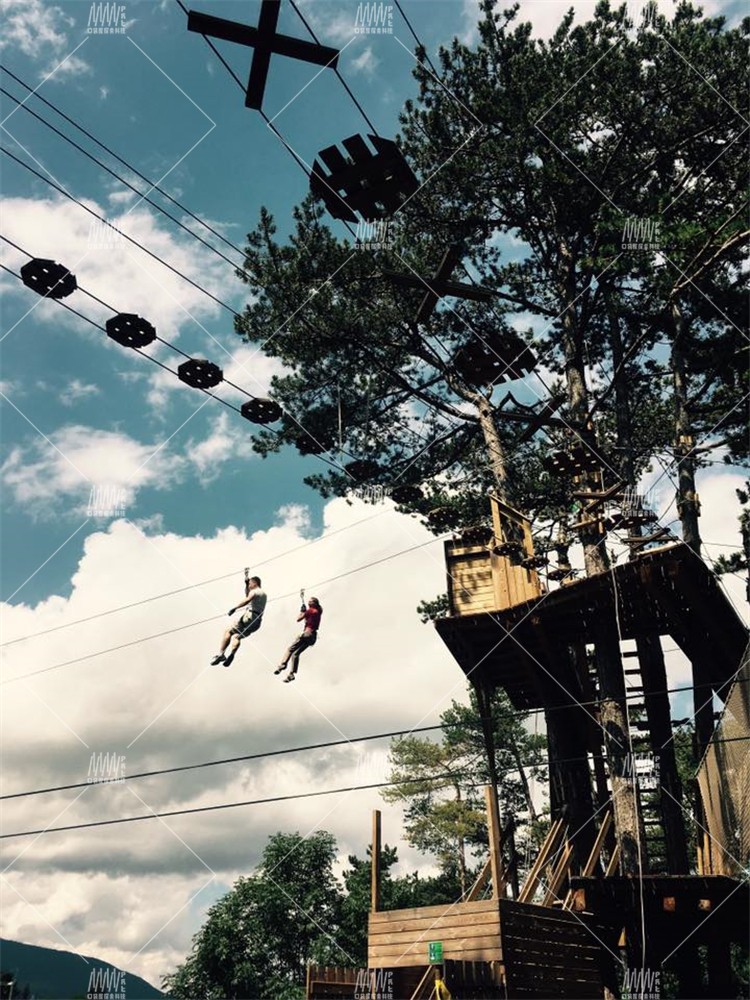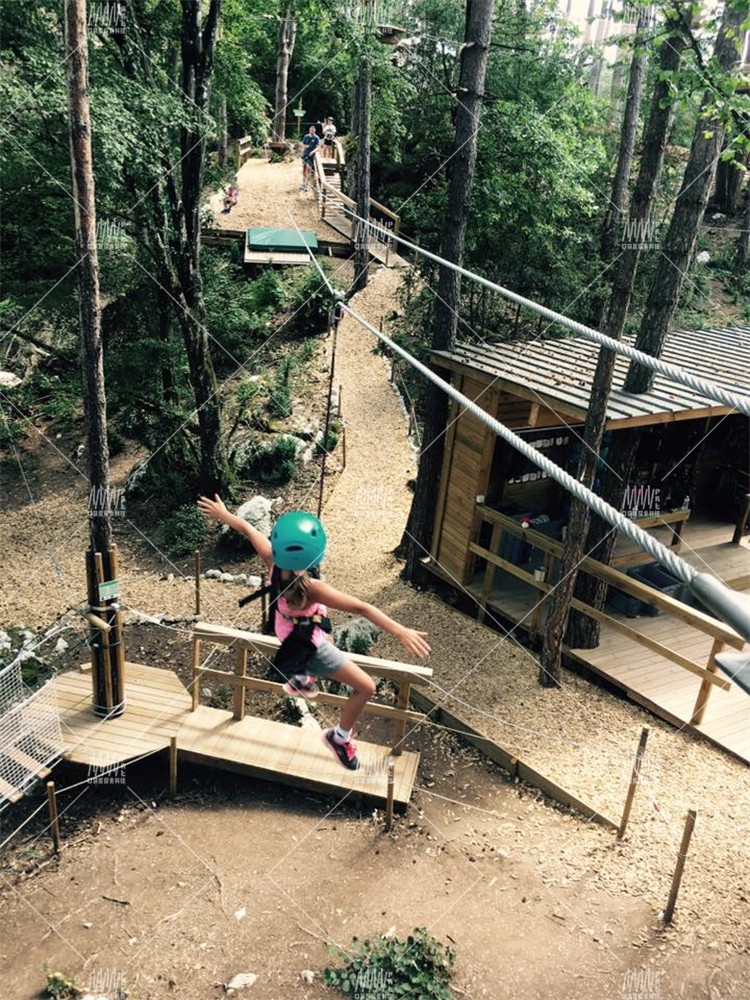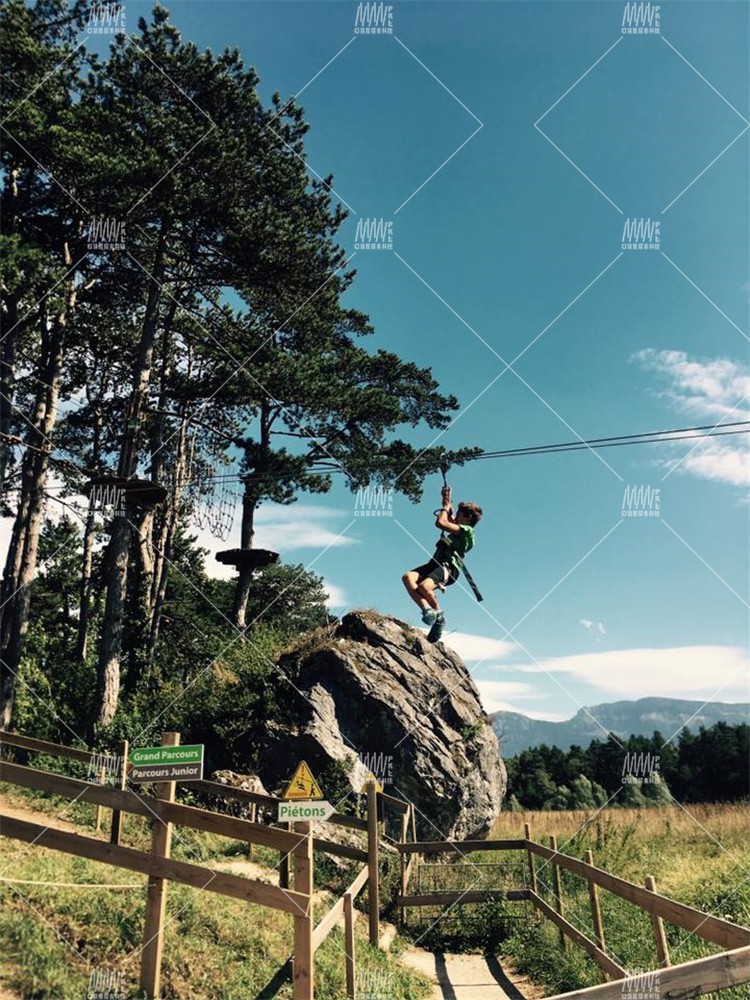Views: 614 Author: silvia Publish Time: 2022-09-02 Origin: Site











What is the working principle of the jungle adventure high-altitude rope / rope?
Continue to last
2. History of aerial ropeway
Although there are not many historical records about the appearance of the first slide rope, there is sufficient evidence to show that people living in mountainous areas, especially the Himalayas and the Alps, set up the slide rope early in their culture to cross dangerous areas and more effectively receive and carry materials.
In the simplest terms, a high-altitude cable is a steel cable whose starting point is higher than the end point. With the natural descent of the slope, a person or goods can travel along the steel cable on the pulley system to minimize friction to help the rider accelerate. An ordinary steel cable supports the weight of a huge person and provides riding services.
Of course, mountaineers have had a preference for high-altitude cables for some time. Although Tirol crossing is a common mountaineering practice (shaking through a line between two steep points, sometimes without pulleys at all), the slide rope is better than Tirol crossing, and it uses the gravity of the slope to make the process faster.
From a more modern point of view, you may be surprised to find that the people who promote the skyrope are reckless thrill seekers known as wildlife biologists. In fact, it is biologists studying dense forest areas who need a way to enter -- or surpass -- the jungle without attention.
It is precisely for this unlikely reason that the slide rope tourism, also known as the "sky curtain tourism", has sprung up in the rainforest of Costa Rica as a leisure activity under the banner of eco-friendly tourism. Promising the adventure of flying over the natural habitat like a bird, these slide tours have become a huge industry in the adventure tourism industry in the region.
The high-altitude rope has also become an important part of the rope challenge course, aiming to teach team spirit and provide entertainment activities through team building and problem solving. Because when you slide along the rope at a high speed on a simple and frightening device and all participants still breathe, the crowd can generally hear applause.
In terms of popularization, the slide rope has risen in the United States and internationally. In fact, according to the statistics of the Challenge Course Technology Association, there are more than 150 courses in the United States alone. Later, we will look at some of the most extreme and intriguing slides in the world. But before that... Safety comes first.

3. Safety of Zipline
The first rule for the safety of sliding rope is to trust professionals. Although any child who has a basic grasp of gravity and pulley can make a slide rope in his or her backyard, professional certification by the professional rope course Association (PRCA) or the Challenge Course Technology Association (acct) can ensure a standardized experience.
Both organizations are now accredited by the American National Standards Institute (ANSI) to develop industry standards and regulations. The European Rope Sports Association is responsible for the supervision of the rope in Europe and the safety certification of the course. Some governments (Australia and Germany) and some states in the United States regulate the rope course
Steve Gustafson, chairman of the board of directors of PRCA, said that when you are inspecting a rope expedition, you should ask the operators about their certification in PRCA or acct and their insurance policies -- usually worth $1 million.
Now, let's talk about the details of the problem that we were really thinking about before we stepped into nothingness. What will happen if the cable breaks? Keep in mind that 250 pounds (113 kg) is usually the weight limit of any rope rider (depending on the company and the specific rope itself), so as not to think that only children are skating.
As Gustafson pointed out, a steel cable "will not fail catastrophically overnight". He said that what we think of as a steel cable is actually seven smaller steel cables wound together, and each of these seven steel cables is actually composed of 19 smaller steel cables. Before the line breaks suddenly, these smaller wires will show signs of wear, and the staff should check the wear signs of the line every day.
Some companies use two smaller cables and two pulleys. Gustafson believes that the use of two small cables not to mention twice as many pulleys, snap rings and other equipment increases the risk of human error and unequal distribution on the cables.
However, if you are taking a double rope system course, you don't have to give up your rope adventure immediately. Gustafson suggests that you must ask whether these cables work together, not whether one of them serves as a "backup".
Think of it as a car tire, Gustafson said; If the right tire has lower pressure than the left tire, the wear will be different. The same is true for ropes - a balanced system makes the system safer.

What does "security" look like?
Of course, you can't immediately judge the safety of a rope trip. But here are a few things you can do to help ensure your safety.
1. As my mother said, wearing a helmet doesn't seem cool until you compare it with your skull when it is crushed. Ensure that there are standard safety equipment including helmets, and that the staff clearly understand the working principle of safety functions (such as safety belts).
Like Disneyland, you must be so high to ride. Make sure you meet the minimum / maximum height and weight limits (depending on the size and limitations of the company, cable and seat belt).
For God's sake, this is not a fashion show -- don't wear your cute high heels or your favorite skirt. Tourists are generally required to wear closed mouth shoes and clothing suitable for outdoor activities.

4. Famous, extreme or extremely famous high-altitude cable line
Now that we know how the tightrope works, why it develops, and the safety and accident risks, consider the tightrope travel you can take. These are not the ropes your neighbors put up in the backyard; These are some serious and creepy adventures, both for fun and work, as we will see.
Costa Rica is a very popular slide rope (or canopy) tourist destination. Flying over the rain forest and crossing the rain forest, the industry has become one of the biggest attractions of Costa Rica.
Sun City in South Africa has the longest and fastest slide rope in the world. It descends into a canyon, 280 meters (918.6 feet) high and 1900 meters (6234 feet) long -- about 1.9 kilometers (1.2 miles). It is said to have a speed of more than 150 kilometers per hour (93.2 miles per hour). But is it the most terrible?
Consider the St. Augustine crocodile farm in St. Augustine, Florida, where people can happily fly over the private fence of a 600 pound (272.2 kg) 13 foot (3.9 m) high Malayan gharial crocodile named Mr. T.
If you are looking for the ultimate tightrope journey in North America, Amanda Arnold, the blogger of the coolest thing on earth, spoke highly of (if height means she has a fear of health and will never avoid) the New York tightrope exploration company in Hunter mountain, where the 3200 foot (975 meter) tightrope reaches 50 miles per hour (80 kilometers per hour) and spans 600 feet (3.9 meters) of valley. Depending on who you are, it may or may not be worse than a 600 pound crocodile.
Just like some awe inspiring students in Colombia, they train every day on the way from isolated villages to schools. At a brisk speed of more than 35 miles per hour (56 kilometers per hour) and falling from a height of 1300 feet (396 meters) into the canyon, these children can almost beat the story of "walking two steps to school on the snow" of others.
How Does Equipment Selection Ensure Long-term Operation of Amusement Venues?
How To Create An Indoor Sports Park Through Planning And Equipment Combination?
What is the working principle of the jungle adventure high-altitude rope / rope? B
What is the working principle of the jungle adventure high-altitude rope / rope? A
content is empty!